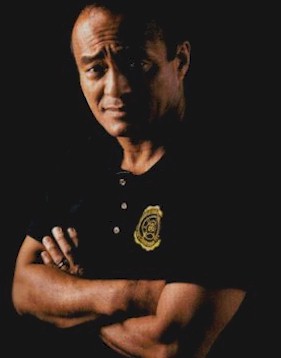Academy of Jeet Kune Do Fighting Technology
Athens
Greece
Jun Fan Jeet Kune Do Instructor
Vagelis Zorbas


RAT (Rapid Assault Tactics)
Rapid
Assault Tactics
or "The R.A.T." System, made famous by Paul Vunak, can
best be described as a way of bringing forth the most violence, using the
most barbaric weapons, to effectively defend ones' life in the most
efficient and safest manner possible. The RAT enables average men
and women to quickly defend themselves against a larger aggressor bent on
your destruction.
This system of brutal combat has been taught to members of the D.E.A.,
S.W.A.T., Army Rangers, Police, F.B.I., and other elite units whose lives
are in danger in many instances.
The RAT System is about survival or self-preservation, and is ideal when a situation has escalated where your life is threatened and the only option is to use the most lethal tools to preserve your life. The central core of this program involves knowing how and when to use head butts, knees and elbows (HKE).
The curriculum is as follows:
-
Training the lethal tools: HKE or head butts, knees and elbows
- Drilling HKE, how to tie it all together to achieve the desired
result
- Functionalizing HKE, training the tools in an alive manner against
full resistance through the use of impact gear
1. Entry
2. Pressure
3. Resolution/Termination of conflict
RAT isn't really so much a fighting technique, though, as it is an understanding of the phases of the fight. Most people enter into a fight with no plan. They just fight until someone runs away, wins, or drops. That's leaving too much up to chance. If you go into a fight with a set plan (entry, pressure, termination) your chances of success goes up greatly.
The scope of the training conducted usually includes but is not limited to:
1. Training Methodologies - numerous drills designed to develop the attributes necessary to execute the techniques learned; as well as to control ones emotions when the fight-or-flight mechanism is triggered
2. Weapons - training in the use and defense of the knife and stick; the same streamlined approach as taught to the US Navy SEALs and other elite government agencies
a)
Stick fighting
is one more aspect to our weapons program and is essentially the same
curriculum that is taught to the SEAL's, DEA, FBI, etc.
Curriculum for this weapon is as follows:
-
Learning the fundamental angles of attack
- Learning fundamental drills
- Functionalizing the techniques learned against:
a. One Aggressor
b. Multiple Aggressors
c. Against a Knife wielder
d. Against a Stick wielder
The emphasis of this weapon's program is to be able to pick up a similar weapon and adapt it in a self-preservation moment. The student will be introduced to the sparring aspects of stick fighting in progressions. This is the only way that one can test and measure the extent of their familiarization with the stick.
b)
Knife fighting.
Our knife program is continually evolving to the degree that the focus is
less on "Knife fighting" per say and more on dealing with common
"Knife assaults." It is essentially the same curriculum
that is taught to the SEAL's, DEA, FBI, etc, except with some
groundbreaking differences where Knife vs. Empty hands from the close
quarter is emphasized.
A Knife assault is probably the single most dangerous threat that one can
encounter, which is why the curriculum is comprised of sound principles
relating to defending against this weapon. We strongly feel that our
approach is unique to that of other existing knife programs because we
continue to address this area with realistic goals and expectations.
Make no mistake, the single best option when confronted is to always run
and avoid the confrontation!
Curriculum for this weapon is as follows:
-
Learning the fundamental angles of attack
- Learning fundamental drills
- Functionalizing the techniques learned against:
a. One Aggressor
b. Multiple Aggressors
c. Against a Knife wielder
d. Against a Stick wielder
- Real Close Quarter Knife Self-Preservation
a. Fighting from the Clinch Range
One of the emphasis of this weapon's program is to be able to pick up a similar weapon and adapt it in a self-preservation moment. The student will be introduced to some the sparring aspects of knife fighting in progressions. Again, we will be emphasizing defending against rather than sparring the knife attack. This is the only way that one can test and measure the extent of their familiarization with the knife.
c) Improvised Weapons (IW), can be taught as a stand alone skill or it can be integrated within the RAT (Rapid Assault Tactics) matrix.
The curriculum is as follows:
-
IW within a home environment
- IW outside environment
- IW in a public place, ex: restaurant, convenient store, etc.
- Functionalizing IW, training the IW in an alive manner against
full resistance through the use of impact gear
3. Mass Attacks - life saving principles and important concepts relating to this area of assault involving multiple aggressors. Mass Attacks is an area of self-preservation that one should never hope to fall victim to. In this most dangerous attack, the options are few and the best tactical response is mobility. The violence in today's streets have changed and one of the most preferred forms of violence by street punks is to attack in numbers. It is a sure fire way to gain the upper hand when the intentions are to seriously hurt someone.
Unfortunately,
many traditional martial arts approach this area unrealistically and the
results are predictable: you will get seriously hurt, possibly killed.
At the Academy of Jeet Kune Do Fighting Technology, we give this area of
Self-preservation serious attention because of the nature of these types
of personal attacks.
The curriculum is based on one of mobility, using the most lethal tools,
improvised weapons and other means.
4. HKE or “Head butts, Knees & Elbows”- the core of the RAT; tools employed when a person is engaged in a life threatening situation and self-preservation becomes necessary
5.
Ground grappling and Ground fighting
- positional control, submissions and
reversals; Concepts of disengaging from grappling situations to maintain
control, mobility and balance. Grappling skills are taught to deal
with any type of grappling that may arise in a street fighting
situation. We develop skills that can be utilized in standup or
ground grappling. The Grappling Arts contain a myriad of
training drills which enhance or develop physical attributes such as
speed, sensitivity, power, coordination, timing, endurance, footwork,
evasiveness, etc. We use the art of grappling to develop skill in
applying arm, foot, wrist, head, neck locks, etc.
There are two ways we teach the ground game. One is strictly from a
self-perfection perspective which is sportive in nature. Meaning, that
students have elected to learn the various locks, submissions,
positioning, reversals, etc, for pure enjoyment and conditioning.
The other way is the Rapid Assault Tactics ground fighting approach. This involves a different sort of dedication, where everything taught is meant for self-preservation only. The aim here is to disengage a grappling confrontation before it proceeds further, but not before initiating all the brutality that may be necessary for one's escape.
Training with gear is the usual norm and is the only way to fully apply and functionalize all the skills that will ensure one's survival. Remember, if you are simulating this aspect of martial arts training, be prepared to suffer the consequences of such ill-preparedness. Train like you fight and you will no doubt fight like you train.
Some training methods and techniques, from various grappling arts, have their way into our curriculum, such as: Gracie Jujitsu, Dumog, Catch-as-Catch Can, Greco, Judo, Shoot Wrestling, etc. It is unfortunate that some martial artists believe that it is unlikely a street fight will end up going to the ground, but in the words of Paul Vunak, "Fights mutate...", and we have to be prepared to survive in that range just in case we end up there. Train realistically and increase your chances of surviving.
